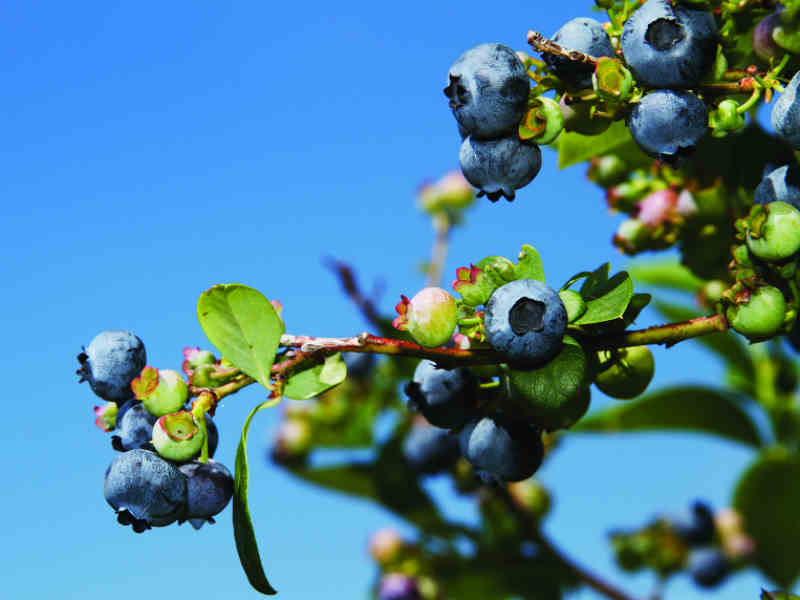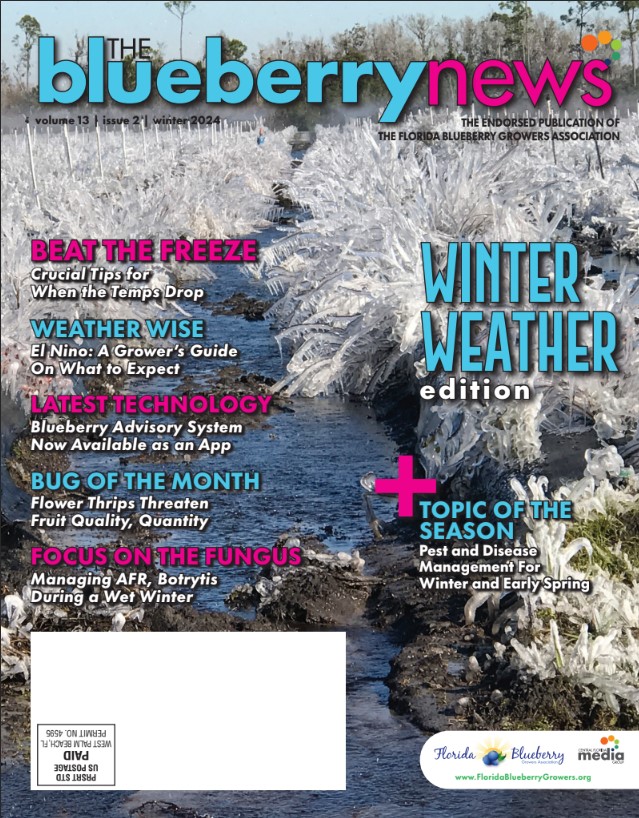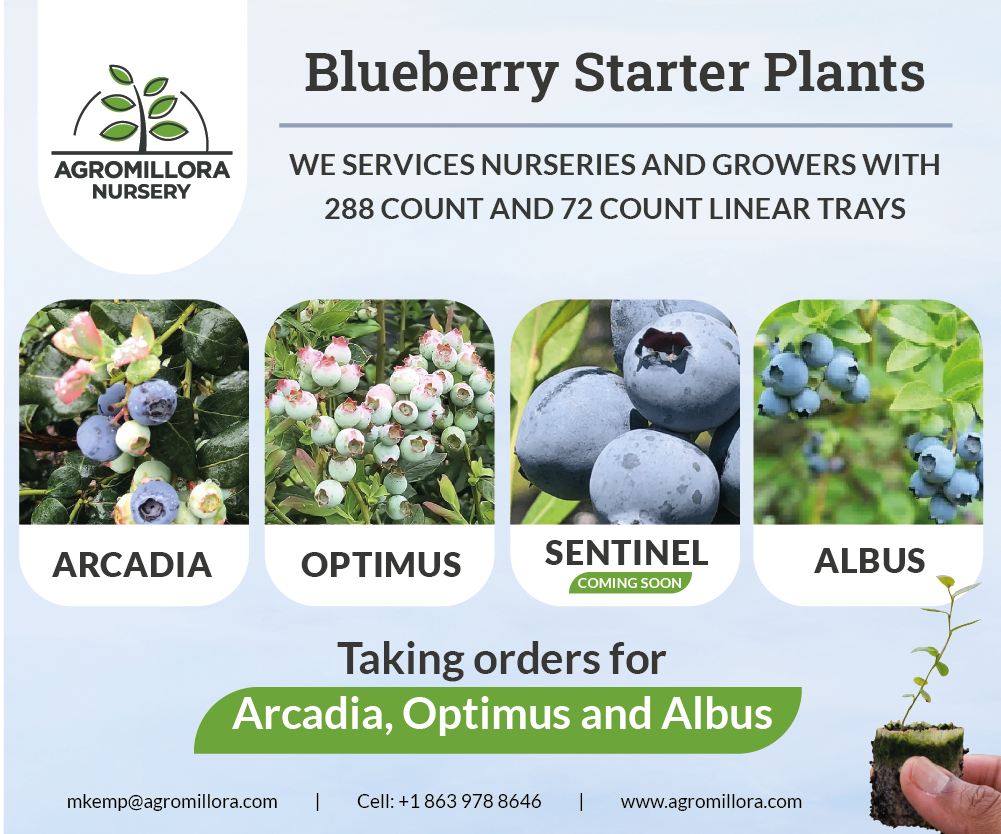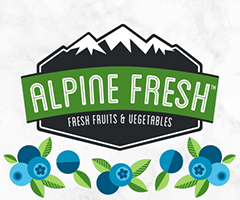Continuing Research on Florida Blueberry Pollination Factors
by Dr. Rachel Mallinger, Assistant Professor, Department of Entomology and Nematology, UF
Blueberries depend on insect pollinators for maximum fruit set. To achieve adequate pollination, blueberry growers stock their fields with managed honey bees and bumblebees, and additionally receive pollination from wild insects.
In recent years, however, Florida blueberry growers have reported poor fruit set, particularly on certain cultivars, which may be due to poor pollination. Various factors can affect pollination success, including weather, plant traits, cultivar planting design, and pollinator abundance and behavior. Enhancing pollination rates and thereby yields thus depends on a multifaceted approach that targets the plant, the growing environment, and the pollinator. Therefore, we will be conducting research to better understand the multiple factors that limit pollination success in order to develop recommendations for enhancing blueberry yields.
Our first objective is to examine variation in pollination requirements and pollen limitation across common southern highbush blueberry cultivars. Growers have reported that some cultivars seem to consistently produce high fruit set, while others consistently have fruit set problems. For this upcoming season, we will compare pollination rates and fruit set across 3-4 cultivars on five farms including Meadowlark, a cultivar with reported low fruit set, and Kestrel, a cultivar with generally high fruit set. On these plants, a set of pollination treatments will be conducted including pollinator-exclusion, hand self-pollination, hand cross-pollination, and open pollination.
By measuring fruit set across these treatments, we will be able to evaluate and compare pollinator-dependency and pollen limitation. In future years, we will expand this study to include additional cultivars, and also evaluate performance of cultivars across a larger number of farms.
Our second objective is to examine the attractiveness of different cultivars to pollinators, including managed honey bees, bumblebees, and other insects, and to determine the plant traits that influence attractiveness. For example, flower shape and color, floral volatiles, and the quantity and composition of nectar and pollen, can all influence a plant’s ability to attract pollinators. For this upcoming season, we will compare pollinator visitation rates to the same 3-4 cultivars described above in order to determine whether differing attractiveness to pollinators affects fruit set.
In future years, we will compare visitation rates to additional blueberry cultivars. Furthermore, we will measure and compare plant traits including nectar quantity and quality, pollen quantity, and flower morphology, and relate these plant traits to pollinator visitation rates and pollinator preferences. This research may inform breeding efforts to develop cultivars with enhanced attractiveness to bees or other pollinators.
Thirdly, we will conduct research to determine optimal stocking densities and deployment strategies for managed bees, and compare the value of managed honey bees, managed bumble bees, and wild bees. We will select farms that utilize different densities of managed bees, and compare pollination success and fruit set as a function of managed bee density.
Additionally, we will add both managed honey bees and bumblebees to farms in order to determine how increasing pollinator density could enhance fruit set. Finally, we will measure pollinator visitation rates at varying distances from deployment location and edge of the field in order to assess uniformity in pollination services across the farm. Results from this study can inform management recommendations including the optimal number of hives per acre, and optimal distribution of hives throughout the field.
Lastly, in future years, we plan to conduct a study on optimal cultivar planting arrangements for enhanced pollination. For this study, we will design a replicated experiment with four different planting design treatments using potted blueberries: solid cultivar blocks, mixed blocks with cultivars alternating every few rows, blocks with cultivars alternating every other row, and blocks with cultivars alternating within the row. Across these treatments, we will evaluate pollination rates and fruit set.
Additionally, we will use this experimental design to examine how pollinators move both across and within rows while foraging on blueberry flowers. To date, there is little information available as to how the arrangement of southern highbush blueberry cultivars can affect pollination rates, and this study will provide useful recommendations for future plantings.
This research will result in a better understanding of the pollination requirements of southern highbush blueberry cultivars, informing cultivar selection and planting. Furthermore, this research will lead to recommendations for the purchase or rental of managed bees, including both honey bees and bumblebees. Current pollination recommendations come from other blueberry growing regions, such as Michigan and New England, and are specific to other cultivated blueberry species (e.g. rabbiteye or lowbush blueberries). Due to the unique climate and growing conditions of Florida, as well as differences across blueberry species, recommendations for pollination success are needed for Florida growers.
Finally, by better understanding the effects of floral traits on pollinator attraction, this research can be used to breed cultivars for enhanced attractiveness to pollinators. Collectively, this research will result in enhanced blueberry yields through increased pollination success.
If you would like to participate in this study, please contact Dr. Rachel Mallinger at [email protected].






